In the realm of culinary exploration, the Dutch oven stands as a stalwart symbol of versatility, a vessel capable of transforming ordinary ingredients into extraordinary feasts.
But as we stand poised before the oven, a question echoes through the chambers of our culinary consciousness: Can the Dutch oven venture where its name implies, into the very heart of the oven’s fiery domain?
Like a culinary riddle waiting to be unraveled, the answer unveils a world of possibilities, where tradition meets innovation, and where the boundaries of kitchen exploration blur into a tantalizing horizon of culinary delight.
Join me as we embark on a journey to uncover the truth behind the enigma: Can the Dutch oven go in the oven?
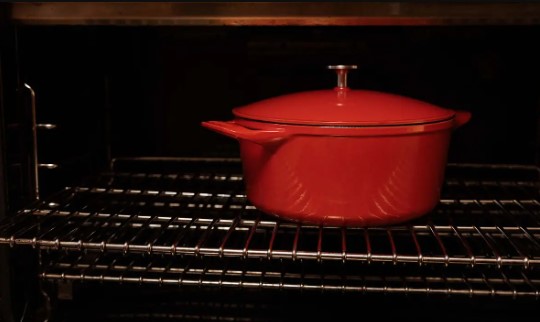
Can Dutch Oven Go In The Oven
Yes, Dutch ovens are designed to be used both on the stovetop and in the oven. In fact, one of the key features of Dutch ovens is their versatility, allowing them to seamlessly transition between different cooking methods.
When using a Dutch oven in the oven, it’s important to ensure that both the pot and its lid are oven-safe. Most Dutch ovens, whether made of traditional cast iron or modern materials like enamel-coated cast iron or stainless steel, are oven-safe up to certain temperatures.
However, it’s essential to check the manufacturer’s instructions for specific temperature limits and guidelines. Exceeding these limits can damage the Dutch oven or its enamel coating, potentially causing it to crack or warp.
Using a Dutch oven in the oven opens up a wide range of cooking possibilities, including braising, roasting, baking bread, and slow-cooking dishes. The thick walls of the Dutch oven ensure even heat distribution, resulting in tender, flavorful dishes every time.
Whether you’re searing meat on the stovetop before transferring it to the oven to finish cooking or baking a hearty casserole, Dutch ovens are a versatile tool that can handle a variety of cooking tasks with ease.
What is a Dutch Oven?
A Dutch oven is a versatile cooking pot typically made of cast iron, with thick walls and a tight-fitting lid. It is a staple in many kitchens due to its durability, excellent heat retention properties, and ability to be used in various cooking methods, including braising, baking, frying, and even as a makeshift slow cooker.
Let’s delve into the details of what a Dutch oven is, its origin, types, versatility, and functionality.
Definition and Origin
The term “Dutch oven” can be somewhat confusing as it doesn’t necessarily originate from the Netherlands. Instead, it is believed to have originated in the 17th century during the early colonial period in America.
Dutch traders brought a cast metal cooking pot to the American colonies, which were sturdy and had excellent heat retention properties. These pots were often referred to as “Dutch ovens” due to their association with the Dutch traders who brought them.
The design of the Dutch oven has evolved over time, but its basic structure has remained relatively consistent. It typically consists of a heavy cast iron pot with thick walls and a tight-fitting lid.
This design allows for even heat distribution and retention, making it ideal for long, slow cooking methods like braising and stewing.
Types of Dutch Ovens
There are several types of Dutch ovens available in the market today, each with its own set of features and advantages. The two primary types are:
- Cast Iron Dutch Oven: This is the classic and most common type of Dutch oven. It is made entirely of cast iron, which provides excellent heat retention and distribution. Cast iron Dutch ovens are highly durable and can last for generations if properly cared for.
- Enameled Cast Iron Dutch Oven: Enameled Dutch ovens have a layer of enamel coating on the interior and sometimes exterior surfaces. This enamel coating prevents the iron from reacting with acidic foods, making it easier to clean and maintain. Enameled Dutch ovens also come in a variety of colors, adding a decorative element to the kitchen.
Versatility and Functionality
The Dutch oven is prized for its versatility and functionality in the kitchen. Some key aspects include:
- Heat Retention: The thick cast iron walls of a Dutch oven retain heat exceptionally well, allowing for even cooking over long periods. This makes it perfect for braising tough cuts of meat, simmering soups and stews, and baking bread.
- Versatile Cooking Methods: Dutch ovens can be used for a wide range of cooking methods, including braising, stewing, frying, baking, and even roasting. Its ability to withstand high temperatures makes it suitable for use on the stovetop, in the oven, or over an open flame.
- One-Pot Cooking: Dutch ovens are often praised for their ability to cook entire meals in a single pot. From sautéing vegetables to searing meat and simmering sauces, everything can be done in one vessel, minimizing cleanup and maximizing flavor.
- Outdoor Cooking: Dutch ovens are also popular for outdoor cooking, particularly camping. Their durable construction and ability to retain heat make them ideal for cooking over a campfire or using charcoal.
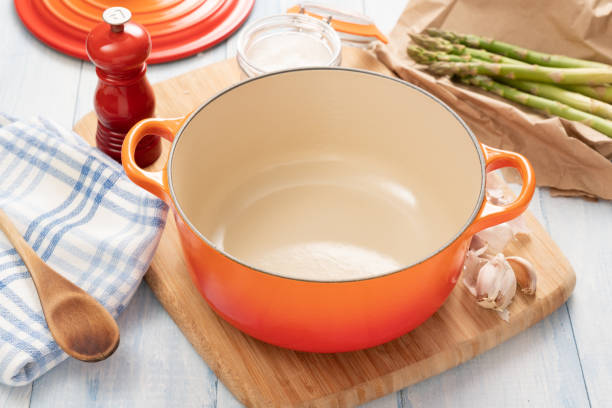
Material Composition of Dutch Ovens
Traditional Cast Iron Dutch Ovens
Traditional cast iron Dutch ovens are crafted entirely from cast iron, a material known for its exceptional heat retention and distribution properties.
These Dutch ovens are typically made by pouring molten iron into molds, resulting in a thick-walled pot that can withstand high temperatures and prolonged use.
The interior surface of traditional cast iron Dutch ovens often develops a natural non-stick seasoning over time, further enhancing their cooking performance. However, they require regular seasoning and maintenance to prevent rust and maintain their non-stick properties.
Despite their weight and maintenance needs, traditional cast iron Dutch ovens are revered for their durability and ability to impart rich flavors to cooked dishes, making them a staple in many kitchens for generations.
Modern Dutch Ovens
Modern Dutch ovens often feature a combination of materials, with cast iron being the primary component supplemented by additional features for convenience and performance. One of the most common modern adaptations is the enameled cast iron Dutch oven.
These Dutch ovens have a layer of enamel coating applied to the interior and sometimes the exterior surfaces, providing several benefits. The enamel coating prevents the iron from reacting with acidic foods, making them easier to clean and maintain compared to traditional cast iron Dutch ovens.
Enameled Dutch ovens come in a variety of colors, adding a decorative element to the kitchen. Another modern variation is the inclusion of additional features such as ergonomic handles, helper handles, and precision-fitted lids with self-basting spikes, enhancing ease of use and cooking performance.
While modern Dutch ovens may lack the rustic charm of their traditional counterparts, they offer added convenience and versatility, making them a popular choice among home cooks and professional chefs alike.
Oven-Safe Dutch Oven Cooking Techniques
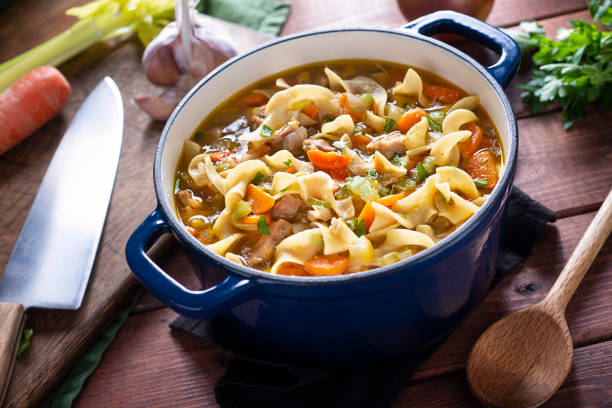
There are several cooking techniques you can employ with an oven-safe Dutch oven. Here are some popular ones:
Braising
Braising involves searing meat or vegetables in fat, then simmering them in a small amount of liquid, covered, in the oven. This technique is perfect for tougher cuts of meat that benefit from slow, moist cooking to become tender.
To braise in a Dutch oven, first, brown the meat or vegetables on the stovetop, then add your liquid (such as broth, wine, or tomato sauce), cover with the lid, and transfer to the oven to cook at a low temperature for an extended period.
Roasting
Roasting involves cooking food, usually meat or vegetables, at high heat in the oven, resulting in caramelization and a crispy exterior. Dutch ovens are excellent for roasting because they retain heat well and ensure even cooking.
Simply place your meat or vegetables in the Dutch oven, season as desired, cover with the lid, and roast in the oven until golden brown and cooked through.
Baking Bread
Dutch ovens are also popular for baking bread, as they create a steamy environment that helps bread develop a crispy crust and airy interior. To bake bread in a Dutch oven, preheat the oven with the Dutch oven inside.
Once hot, carefully remove the Dutch oven, place the shaped bread dough inside, cover with the lid, and bake until golden brown and crusty.
Slow-Cooking
Dutch ovens are perfect for slow-cooking dishes like stews, soups, and chili. The thick walls of the Dutch oven retain heat well, allowing for long, slow cooking at low temperatures.
Simply combine your ingredients in the Dutch oven, cover with the lid, and transfer to the oven to cook slowly until the flavors meld and the dish is tender and delicious.
Casseroles and One-Pot Meals
Dutch ovens are ideal for making hearty casseroles and one-pot meals. Whether you’re making a classic beef stew, a comforting chicken pot pie, or a creamy pasta bake, Dutch ovens can handle it all.
Simply combine your ingredients in the Dutch oven, cover with the lid, and bake until bubbly and golden brown.
How to Safely Use Dutch Ovens in the Oven
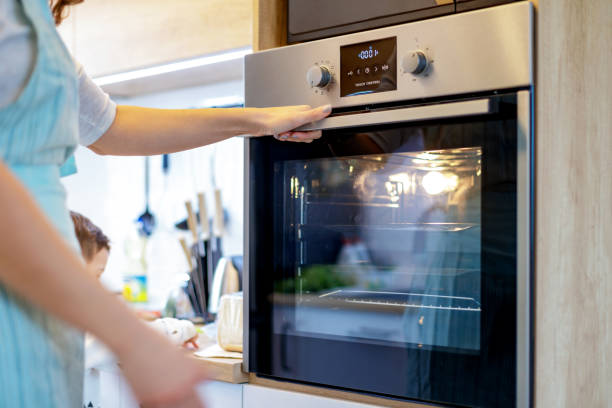
Using Dutch ovens in the oven is generally safe, but there are some important precautions and guidelines to follow to ensure safety and prevent damage to the Dutch oven and your oven. Here’s how to safely use Dutch ovens in the oven:
Check the Oven-Safety
Before using a Dutch oven in the oven, always check the manufacturer’s instructions to ensure that it is oven-safe. Most Dutch ovens made of cast iron, enamel-coated cast iron, or stainless steel are oven-safe, but it’s essential to verify the specific temperature limits.
Preheat the Oven
When using a Dutch oven in the oven, preheat the oven to the desired temperature before placing the Dutch oven inside. Preheating ensures that the oven and Dutch oven are both at the correct temperature for cooking.
Use Oven Mitts
Dutch ovens become extremely hot when placed in the oven, so always use oven mitts or pot holders when handling them. This includes when placing them in the oven, removing them from the oven, and handling them while cooking.
Handle with Care
When transferring a hot Dutch oven from the stovetop to the oven or vice versa, handle it with care to avoid burns and spills. Use both hands to support the weight of the Dutch oven and keep it level to prevent hot liquids from spilling.
Avoid Sudden Temperature Changes
Avoid subjecting the Dutch oven to sudden temperature changes, as this can cause thermal shock and potentially lead to cracking or warping. For example, never place a hot Dutch oven directly under cold water or on a cold surface.
Monitor Cooking Progress
Keep an eye on your food while it’s cooking in the oven to prevent it from overcooking or burning. Use an oven-safe thermometer to ensure that meats reach the appropriate internal temperature for safe consumption.
Use the Lid
When cooking with a Dutch oven in the oven, always use the lid unless the recipe specifies otherwise. The lid helps trap steam and heat inside the Dutch oven, ensuring even cooking and preventing food from drying out.
Allow for Ventilation
When using a Dutch oven in the oven, make sure there is adequate ventilation to allow steam to escape. This prevents pressure from building up inside the Dutch oven and helps prevent spillovers or accidents.
Advantages of Using Dutch Ovens in the Oven
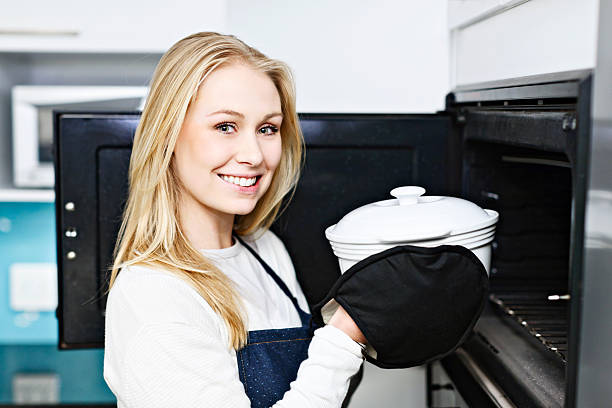
Using Dutch ovens in the oven offers several advantages that make them a versatile and indispensable tool in the kitchen. Here are some of the key advantages:
Even Heat Distribution
Dutch ovens, especially those made of cast iron, are known for their excellent heat retention and distribution properties. When placed in the oven, Dutch ovens distribute heat evenly throughout the cooking vessel, ensuring that food cooks uniformly and consistently.
Versatility
Dutch ovens are incredibly versatile and can be used for a wide range of cooking techniques in the oven. Whether you’re braising, roasting, baking bread, slow-cooking, or making one-pot meals, a Dutch oven can handle it all. This versatility makes Dutch ovens a go-to tool for many home cooks.
Retains Moisture
Dutch ovens are designed with tight-fitting lids that help trap moisture and steam inside the pot. This creates a moist cooking environment that’s perfect for braising meats, simmering stews, and baking bread. The result is tender, flavorful dishes with succulent meats and perfectly baked bread with a crispy crust.
Excellent for Long, Slow Cooking
Dutch ovens are ideal for long, slow cooking methods like braising and stewing. When placed in the oven at a low temperature, Dutch ovens maintain a consistent heat that gently cooks food over an extended period.
This allows tough cuts of meat to become tender and flavorful and allows flavors to meld and develop in soups and stews.
One-Pot Cooking
Dutch ovens are perfect for one-pot cooking, where all the ingredients are cooked together in a single vessel. This not only simplifies the cooking process but also reduces the number of dishes to clean afterward.
Whether you’re making a hearty stew, a savory casserole, or a comforting pot roast, Dutch ovens make it easy to create delicious meals with minimal fuss.
Durable and Long-Lasting
Dutch ovens, especially those made of cast iron, are incredibly durable and can last for generations if properly cared for. They are resistant to warping, scratching, and staining, making them suitable for heavy-duty cooking. With proper maintenance, Dutch ovens can provide years of reliable service in the kitchen.
Enhanced Flavors
The even heat distribution and moisture retention properties of Dutch ovens help enhance the flavors of food as it cooks. Whether you’re searing meats, caramelizing vegetables, or simmering sauces, Dutch ovens help unlock the natural flavors of ingredients, resulting in delicious and satisfying meals.
Precautions and Tips for Using Dutch Ovens in the Oven
Using Dutch ovens in the oven is a common practice, but it’s essential to take certain precautions and follow some tips to ensure safe and successful cooking. Here are some precautions and tips for using Dutch ovens in the oven:
Precautions
- Check Oven-Safety: Ensure that your Dutch oven is oven-safe by checking the manufacturer’s instructions. Most Dutch ovens made of cast iron, enamel-coated cast iron, or stainless steel are oven-safe, but it’s crucial to verify specific temperature limits.
- Handle with Oven Mitts: Dutch ovens become extremely hot when placed in the oven, so always use oven mitts or pot holders when handling them. This includes when placing them in the oven, removing them from the oven, and handling them while cooking.
- Avoid Sudden Temperature Changes: Prevent thermal shock by avoiding sudden temperature changes. Don’t place a hot Dutch oven directly onto a cold surface or under cold water, as this can cause it to crack or warp.
- Use Proper Ventilation: Ensure adequate ventilation in your kitchen when using Dutch ovens in the oven. This allows steam to escape, preventing pressure from building up inside the Dutch oven and reducing the risk of spillovers or accidents.
- Keep Children and Pets Away: Keep children and pets away from the oven and cooking area when using Dutch ovens. The oven and Dutch oven can be extremely hot and pose a burn risk.
Tips
- Preheat the Oven: Preheat the oven to the desired temperature before placing the Dutch oven inside. Preheating ensures that both the oven and Dutch oven are at the correct temperature for cooking.
- Season Cast Iron Dutch Ovens: If using a cast iron Dutch oven, ensure that it is properly seasoned before use. Seasoning creates a natural non-stick surface and helps prevent rusting.
- Use the Lid: When cooking with a Dutch oven in the oven, always use the lid unless the recipe specifies otherwise. The lid helps trap steam and heat inside the Dutch oven, ensuring even cooking and preventing food from drying out.
- Monitor Cooking Progress: Keep an eye on your food while it’s cooking in the oven to prevent it from overcooking or burning. Use an oven-safe thermometer to ensure that meats reach the appropriate internal temperature for safe consumption.
- Allow for Resting Time: After cooking, allow the Dutch oven to cool for a few minutes before removing the lid or transferring the food. This allows excess steam to escape and helps prevent burns.
- Clean and Maintain Properly: After each use, clean the Dutch oven according to the manufacturer’s instructions. Avoid using harsh abrasives or metal utensils that could damage the surface. Proper maintenance will ensure that your Dutch oven lasts for many years.
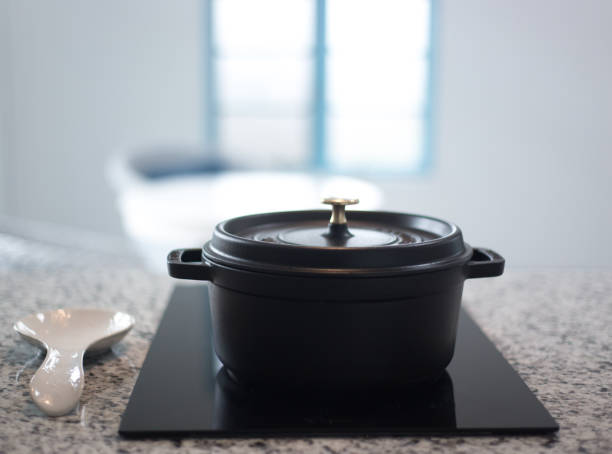
Frequently Asked Questions (FAQs) – Using Dutch Oven In The Oven
Can I really put my Dutch oven in the oven?
Yes, indeed! Dutch ovens are designed to be versatile cookware, capable of seamlessly transitioning from stovetop to oven, making them perfect for a wide range of recipes.
Is it safe to use my Dutch oven in the oven?
Absolutely! Dutch ovens are typically crafted from durable materials like cast iron or enamel-coated cast iron, ensuring they can handle high temperatures without any issues. So go ahead and cook with confidence!
Will using my Dutch oven in the oven affect its performance?
Not at all! In fact, utilizing your Dutch oven in the oven can enhance its versatility and cooking capabilities. From baking artisan bread to slow-cooking tender roasts, the oven is just another stage for your Dutch oven to shine.
Are there any special tips for using my Dutch oven in the oven?
While Dutch ovens are quite versatile, it’s always a good idea to use oven mitts or pot holders when handling them, as they can get quite hot. Additionally, consider preheating your Dutch oven along with your oven for more even cooking results.
Can I bake bread in my Dutch oven in the oven?
Absolutely! Baking bread in a Dutch oven is a game-changer. The enclosed environment helps create steam, resulting in a beautifully crispy crust and a soft, fluffy interior. Get ready to impress your friends and family with your homemade artisan loaves!
Will using my Dutch oven in the oven make cleanup difficult?
Not at all! Many Dutch ovens come with enamel coatings that make cleanup a breeze. Simply let your Dutch oven cool down after use, then wash it with warm, soapy water. Plus, the more you use your Dutch oven, the better it gets!
Can I use my Dutch oven in the oven for desserts?
Absolutely! From cobblers to crisps, your Dutch oven is the perfect vessel for creating delicious desserts. Its even heat distribution ensures that your sweet treats bake to perfection every time. Get ready to indulge in some mouthwatering desserts straight from your oven!
Can I use my Dutch oven in the oven for long cooking times?
Certainly! Dutch ovens excel at slow-cooking dishes to perfection, whether it’s simmering a hearty stew or braising tender meats. Their thick walls and snug-fitting lids ensure that heat is retained, resulting in flavorful meals that melt in your mouth.
Are there any recipes specifically designed for using a Dutch oven in the oven?
Absolutely! There’s a plethora of recipes tailored to make the most of your Dutch oven’s oven-friendly features. From savory casseroles to succulent one-pot meals, the possibilities are endless. Explore new culinary horizons and let your Dutch oven take center stage in your kitchen creations!
Can I use my Dutch oven in the oven for outdoor cooking, such as camping or barbecues?
Without a doubt! Dutch ovens are not only versatile for indoor cooking but also excel in outdoor settings. Whether you’re camping, having a backyard barbecue, or enjoying a picnic, your Dutch oven can be your trusted companion for preparing delicious meals over open flames or charcoal. Get ready to elevate your outdoor culinary adventures with the convenience and versatility of your Dutch oven!
Conclusion
In conclusion, the Dutch oven’s versatility in both stovetop and oven use makes it a fundamental tool in any kitchen.
With its durable construction and ability to withstand high temperatures, the Dutch oven proves to be not only oven-safe but also an essential vessel for a wide range of cooking techniques, from braising and baking to roasting and stewing.
Its seamless transition from stovetop to oven ensures consistent and flavorful results, making it a dependable ally for home cooks and professional chefs alike.
Whether preparing hearty stews, crusty bread, or succulent roasts, the Dutch oven’s compatibility with oven use adds another dimension of convenience and efficiency to culinary endeavors.
Related Posts: